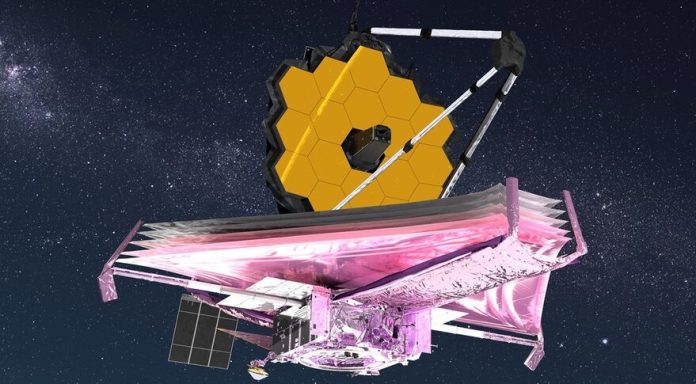
JWST begins sunshield tensioning (Image Credit: SNN)

WASHINGTON — Spacecraft controllers started the final steps in the deployment of the sunshield of the James Webb Space Telescope Jan. 3 after fixing two minor issues with the spacecraft.
NASA announced late Jan. 3 that it had completed the tensioning of three of the five layers of aluminum-coated Kapton that comprise the sunshield, which blocks sunlight from reaching the telescope and its instruments to cool them. That tensioning process, involving a series of motors, pulleys and cables, stretches the layers into the final shape and ensures proper separation between the layers.
That work appeared to be going faster than expected. During a briefing with reporters around midday Jan. 3, Bill Ochs, JWST project manager at NASA’s Goddard Space Flight Center, said tensioning of the outermost of the five layers had started, with plans to work inward layer by layer.
“Today we are focused on tensioning layer 1. Layer 1 will take most of the day,” he said. “Tomorrow through Wednesday we will deploy layers 2 through 5.”
With three of the five layers already deployed, though, NASA now expects to complete the final two layers, and thus the overall sunshield deployment process, Jan. 4. “This was the hardest part to test on the ground, so it feels awesome to have everything go so well today,” said James Cooper, JWST sunshield manager at Goddard, in a NASA statement late Jan. 3. “The Northrop and NASA team is doing great work, and we look forward to tensioning the remaining layers.”
The tensioning was originally scheduled to start the day after the deployment of two booms on either side of the spacecraft that extended the sunshield to its full area. However, that deployment took longer than expected Dec. 31, and managers decided to give controllers the day off Jan. 1 to rest.
Engineers then spent Jan. 2 resolving two minor issues with the spacecraft. One involved what Ochs described as a “preset max duty cycle” setting in the solar arrays that kept them from producing enough power to meet all the spacecraft needs. As a result, the spacecraft was using its battery in addition to power from the arrays.
Amy Lo, vehicle engineering lead for JWST and prime contractor Northrop Grumman, said at the media briefing that controllers “rebalanced” the array by adjusting settings on each of its five individual panels. “We got the arrays to where they ought to be in order to provide the power that we need on Webb. We’re power-positive, the arrays look good,” she said.
The other issue involved motors used for the tensioning process whose temperatures were higher than expected although still within conservative engineering margins. Controllers adjusted the orientation of the spacecraft temporarily to reduce the amount of sunlight hitting, and heating up, the motors. “They’re nice and cool,” Lo said of the motors. “We’ve got a lot of margin now on our temperature.”
Once the sunshield is fully tensioned, spacecraft controllers will turn their attention to JWST’s mirrors. Ochs said the tripod holding the secondary mirror could be deployed late in the week, followed over the weekend by two wings holding segments of the primary mirror as well as an aft radiator.
Getting the sunshield in place, though, will be a major step toward completing the full deployment of JWST. Ochs estimated that, once the sunshield is fully tensioned, the mission will have retired 70–75% of the 344 single-point failures in the spacecraft.
“When I get asked, ‘What keeps you up the most at night?’ obviously it’s the sunshield deployment,” he said. “I don’t expect any drama. I always tell folks, the best thing for operations is boring, and that’s what we anticipate over the next three days, to be boring. I think we’ll all breathe a sigh of relief once we get to the final layer, layer 5, tensioning. But I don’t expect drama.”
– Advertisement –





